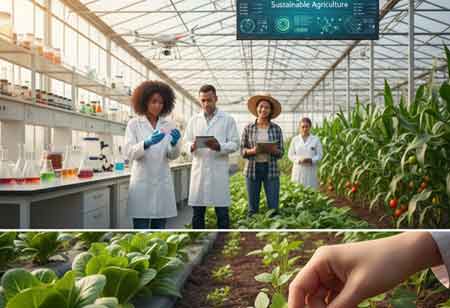Thank you for Subscribing to Agri Business Review Weekly Brief
Rebuilding Agroecosystems Through Regenerative Nutrition Practices in Latin America
A shift in agriculture is occurring, recognizing soil as a living ecosystem. Regenerative practices and microbial inoculants are crucial for sustainable farming and enhancing soil health.

By
Agri Business Review | Wednesday, November 05, 2025
Stay ahead of the industry with exclusive feature stories on the top companies, expert insights and the latest news delivered straight to your inbox. Subscribe today.
After decades of viewing soil merely as an inert root-holding medium for synthetic inputs, a new paradigm is emerging that recognizes soil as the living engine driving the entire agroecosystem. This new approach, grounded in the principles of regenerative agriculture, positions soil health as the cornerstone of long-term productivity, resilience, and nutritional quality. It is a strategic pivot from short-term chemical inputs to the long-term biological cultivation of natural capital.
At the heart of this transformation is the concept of regenerative nutrition. This is the practice of feeding the soil’s intricate web of life, which in turn feeds the plant. It is a system built on microbiology, focused on restoring the natural cycles that have sustained life for millennia. Instead of merely applying soluble chemical fertilizers, regenerative nutrition focuses on activating the biological machinery within the soil to unlock, capture, and cycle nutrients. This "living system" approach is moving from a niche concept to a global imperative, and nowhere is this biological future more evident than in Latin America.
Microbial Inoculants: The Tools of Regenerative Activation
If the soil is the engine, microbial inoculants are the high-performance activators that kickstart and optimize its function. These are not fertilizers in the traditional sense; they are concentrated, living biological products designed to introduce or augment specific, beneficial microbial populations in the soil.
The agricultural industry is rapidly advancing the sophistication of these tools. The focus has expanded from single-strain products to complex "consortia" that combine multiple species of bacteria and fungi. These multifunctional inoculants can perform several tasks at once—fixing nitrogen, solubilizing phosphate, promoting root growth, and enhancing soil structure.
The power of this approach lies in its precision. By analyzing the functional needs of a specific soil or crop, it is possible to apply a tailored biological solution that restores a missing or weak link in the soil food web. This represents a paradigm shift from a "one-size-fits-all" chemical approach to a customized, biological one that works in concert with nature.
The Power of BNF: Nature's Fertilizer Factory
Nitrogen is the most critical nutrient for plant growth, and its synthetic production is one of the most energy-intensive processes in modern industry. Biological Nitrogen Fixation, however, is an elegant, natural process that has been occurring for eons. It is performed by a special class of bacteria, known as diazotrophs, which possess the unique ability to capture inert nitrogen gas (N₂) from the atmosphere—which makes up 78 percent of the air we breathe—and convert it into ammonia (NH₃), a form plants can readily absorb.
Some of the best-known of these bacteria are in the Rhizobium group, which form symbiotic nodules on the roots of legumes such as soybeans, beans, and peas. The plant provides the bacteria with sugars from photosynthesis, and in return, the bacteria provide the plant with a constant, on-demand supply of nitrogen.
This process is the pinnacle of regenerative nutrition. It is a self-sustaining, in-situ fertilizer factory that operates at the root zone, feeding the plant precisely what it needs, when it needs it. The integration of BNF into mainstream agriculture is the single most significant step toward a truly regenerative system.
Latin America: A Global Blueprint for Biological Agriculture
While the concepts of soil health and microbial inoculants are gaining traction worldwide, Latin America stands as a global leader in their large-scale, practical application. The region has, for decades, built a mature and sophisticated agricultural ecosystem grounded in biological principles, particularly in BNF and microbial inoculants.
This leadership did not happen by chance. It is the result of long-term, focused investment in public and private research, creating a deep well of scientific understanding and practical expertise. This scientific foundation enabled the development and widespread adoption of highly effective, locally adapted microbial strains.
In the vast agricultural heartlands of South America, the use of inoculants for legumes, especially soybeans, is not an alternative practice; it is the standard. Millions of hectares are cultivated annually using BNF as the primary source of nitrogen. This continental-scale adoption has demonstrated beyond a doubt that it is possible to power high-yield, world-class agricultural production through biological systems.
The region’s innovation extends well beyond the development of rhizobia for soybeans, positioning Latin America as a global leader in agricultural biotechnology. Its advancements encompass several key areas. Co-inoculation—the simultaneous application of multiple beneficial microbes, such as nitrogen-fixing Rhizobium combined with phosphate-solubilizing bacteria or plant growth-promoting microorganisms like Azospirillum—has become a hallmark practice. This synergistic approach amplifies plant health, nutrient uptake, and productivity across crops such as maize and grasses. Associative nitrogen fixation represents another frontier, where Latin American research and field applications are pioneering the use of bacteria living near or on the roots of non-legume crops, such as corn and wheat, supplying them with significant nitrogen inputs without forming nodules.
Complementing these biological innovations is the region’s sophistication in formulation technology, evidenced by advanced products ranging from liquid and peat-based inoculants to on-seed treatments designed to maintain microbial viability and performance under diverse field conditions. Collectively, these achievements make Latin America a global blueprint for sustainable intensification, demonstrating that a biology-first approach is not merely aspirational but a proven, scalable, and highly productive agricultural reality.
The move toward regenerative nutrition practices is accelerating as the benefits—optimized plant nutrition, enhanced system stability, and the creation of self-renewing natural capital—become undeniable. Microbial inoculants and the harnessing of natural processes, such as Biological Nitrogen Fixation, are the primary tools for this transformation.
Latin America has provided the model, proving that biological solutions can successfully underpin an entire continent's agricultural output. As the rest of the world follows this path, we are not just changing farming techniques; we are fundamentally rebuilding our agroecosystems from the ground up, starting with the living soil. The future of agriculture is, without question, biological.





